Vanities – The Musical
While it does not offer any new revelations or insights, the musical of Jack Heifner's long running play abotu three female best friends over 26 years is a diverting and very entertaining evening.
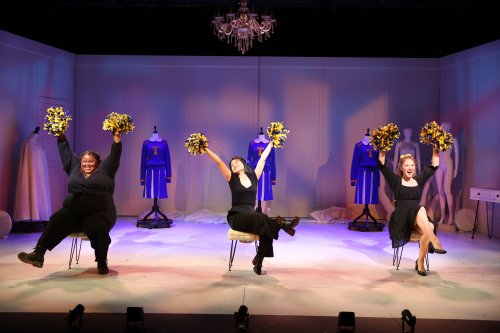
Jade Jones, Amy Keum and Hayley Podschun in a scene from York Theatre Company’s production of “Vanities – The Musical” at Theatre at St. Jean’s (Photo credit: Carol Rosegg)
[avatar user=”Victor Gluck” size=”96″ align=”left”] Victor Gluck, Editor-in-Chief[/avatar]
Jack Heifner’s play, Vanities, about three best female friends and their changing relationships over 11 years, was one of the longest running plays in Off Broadway history racking up 1,785 performances from 1976 to 1979. In 2009, Heifner turned it into a musical with composer/lyricist David Kirshenbaum (Summer of ’42). While the original play covered the years 1963 to 1974, the musical which premiered in New York at The Second Stage brought the story up to 1990. Now The York Theatre Company has revived the musical in a vigorous and animated production directed by Will Pomerantz. The three actresses (Jade Jones, Amy Keum and Hayley Podschun) make the three friends extremely different which adds to the fun.
Possibly in the attempt to save time, the production has made some unusual design choices: James Morgan’s set remains a white box throughout with chairs used in different scenes. The actresses all wear black throughout the evening but push in three mannequins with different and colorful clothes styles (from designer Barbara Erin Delo) for the four sequences. At times Mike Billings’ lighting design turns the stage blue, purple or pink. It takes a bit of getting used to, but eventually it works as a minimalist concept.
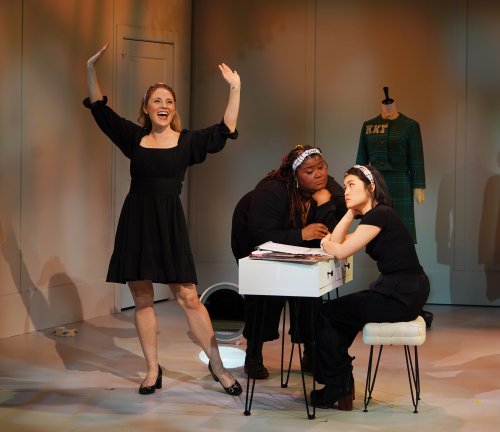
Hayley Podschun, Jade Jones and Amy Keum in a scene from York Theatre Company’s production of “Vanities – The Musical” at Theatre at St. Jean’s (Photo credit: Carol Rosegg)
The musical begins in November 1963 while Mary, Kathy and Joanne are high school cheerleaders in a small town with Kathy in charge as she is the most organized of the three. From the beginning, only Joanne seems to know what she wants, marriage and children, while the others have greater ambitions. Mary is the most sexually liberated even as a teenager. The scene ends when an announcement is made over the school’s public address system that the President has been shot. Joanne who has no interest in current events or politics thinks it refers to the student government president.
We next meet the young woman as college seniors in 1968 all living in the same sorority in Dallas, Kappa Kappa Gamma. While Joanne is planning her wedding, Kathy is not certain what she wants to do after graduation while Mary can’t wait to get away from her mother and travel in Europe. Obviously, they are going off in different directions.
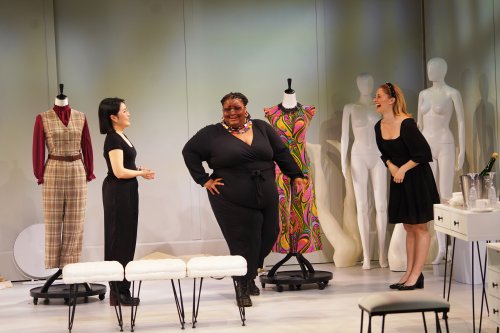
Amy Keum, Jade Jones and Hayley Podschun in a scene from York Theatre Company’s production of “Vanities – The Musical” at Theatre at St. Jean’s (Photo credit: Carol Rosegg)
They next get together in 1974 at Kathy’s penthouse apartment in New York, where it appears they have grown apart. Joanne now lives in Connecticut and has had three children with her lawyer husband Ted who seems to work late a great deal. Mary owns a large gallery of art erotic in Manhattan which Joanne has refused to visit, and Kathy reveals that she has quit teaching and is taking some time off. When one of them makes a devastating revelation, it seems that the friendships may be broken permanently.
Sixteen years later, the three meet back in their original Texas home town at the funeral for Mary’s mother. Joanne is now divorced and finding herself while Kathy has become a successful novelist. Mary lives and works in the art world in London. They not only make up but realize that they have missed each other and that their friendships are for life.
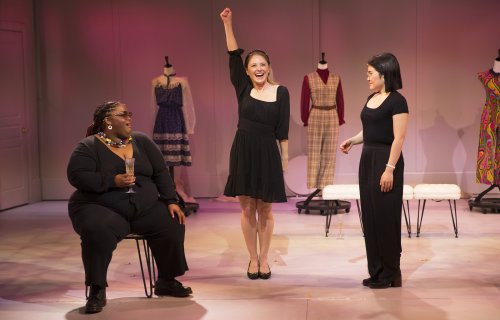
Jade Jones, Hayley Podschun and Amy Keum in a scene from York Theatre Company’s production of “Vanities – The Musical” at Theatre at St. Jean’s (Photo credit: Carol Rosegg)
Although the women grow up and change over the 26 years we see them, Heifner’s book tends to stay away from politics and the women’s movement other than mentioning markers like Kennedy, Nixon and Bob Dylan. However, the dialogue is bright and lively. The show is definitely a period piece ending as it does in 1990 but there are probably women who still live these lives. While in no way taking a feminist point of view, the characters do evolve and change over the years.
The transitions are neatly accomplished through Kirshenbaum’s songs: the song “Mystery,” about staying beautiful, is sung before each of the four scenes by the company with new lyrics: in high school the girls sing of beauty products; in college they sing of admired cosmetics; six years later, they have decided it is less about clothes and looking in the mirror, and after 16 more years, the women sing of products to disguise aging. Songs are also used to reveal the changes over the years. The song “An Organized Life” appears in three of the scenes: first about routines in high school, second about sorority life, and finally Kathy sings about wanting a simpler life after she has quit teaching and is trying to find what she really wants.
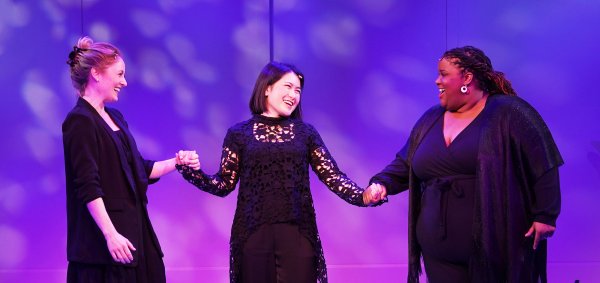
Hayley Podschun, Amy Keum and Jade Jones in a scene from York Theatre Company’s production of “Vanities – The Musical” at Theatre at St. Jean’s (Photo credit: Carol Rosegg)
The cast is uniformly fine and all sing well. Amy Keum’s Kathy, the overly organized one, takes the greatest journey of the three ending up in Montana by the end and a career very different than how she started. Hayley Podschun’s Joanne, the conservative who only aspired to be a homemaker and avoided taking sides in most issues, eventually discovers that she did not have it all. Jade Jones’ Mary changes the least, remaining avant-garde and liberal in her thinking throughout, continuing to make decisions that please her. The three work well together, particularly as they are very different types both physically and in personality.
Vanities – The Musical is rather tame and dated as it doesn’t go past 1990 but extremely well-acted and staged. While it does not offer any new revelations or insights, it is a diverting musical and very entertaining. It will hold your interest even if you can see where it is going long before it gets there. The engaging and appealing cast is delightful company for the evening.
Vanities – The Musical (through April 22, 2023)
The York Theatre Company in association with Riki Kane Larimer
Theatre at St. Jean’s, 150 E. 76th Street, in Manhattan
For tickets, call 212-935-5820 or visit http://www.YorkTheatre.org
Running time: one hour and 45 minutes without an intermission






Leave a comment